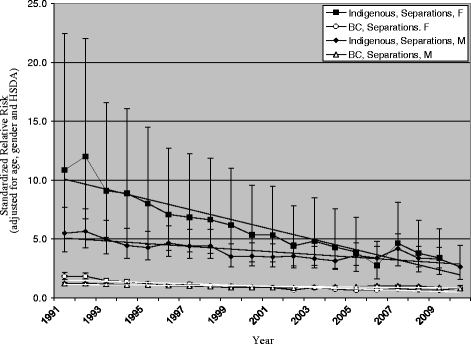Intentional injury among the indigenous and total populations in British Columbia, Canada: trends over time and ecological analyses of risk
- PMID: 28789649
- PMCID: PMC5549349
- DOI: 10.1186/s12939-017-0629-4
Intentional injury among the indigenous and total populations in British Columbia, Canada: trends over time and ecological analyses of risk
Abstract
Background: Our objective was to explore intentional injury disparity between Indigenous populations and the total population in the province of British Columbia (BC), Canada. We focus on hospitalizations, including both self-inflicted injuries and injuries inflicted by others.
Methods: We used data from BC's universal health care insurance plan, 1991 to 2010, linked to Vital Statistics databases. Indigenous people were identified through the insurance premium group, and birth and death records. Place of residence was identified through postal code. We calculated crude hospitalization incidence rates and the Standardized Relative Risk (SRR) of hospitalization, standardized by gender, 5-year age group, and Health Service Delivery Area (HSDA). With HSDA populations as the units of observation, linear regression was used to test hypothesized associations of Indigenous ethnicity, geographic, and socio-economic characteristics with SRR of injury.
Results: During the period 1991-2010, the crude rate of hospitalization for intentional injuries was 8.4 per 10,000 person-years (95% confidence interval (CI): 8.3 to 8.5) for the total BC population, compared to 45.3 per 10,000 (95% CI: 44.5 to 46.1) for the Indigenous population. For both populations, risk declined over the period for injuries self-inflicted and inflicted by others. The linear regression model predicts that the off-reserve Indigenous population will have SRR of intentional injury 3.98 greater, and the on-reserve Indigenous population 4.17, greater than the total population. The final model was an excellent fit (R2 = 0.912, F = 177.632, p < 0.001), and found that three variables - occupational risk, high school diploma, and university degree - each provide independent effects when interacting multiplicatively with Indigenous ethnicity.
Conclusions: The observation of substantially declining rates of intentional injury for both the Indigenous and total BC populations is off-set by the high disparity in risk between the two populations, which will likely continue until Canada reduces disparity with respect to discriminatory practices, and physical, social, and economic conditions.
Keywords: Aboriginal; American Indian; Canada; Hospitalization; Indigenous population; Inequities; Suicide, attempted; Wounds and injuries.
Conflict of interest statement
Ethics approval and consent to participate
The University of British Columbia Behavioural Research Ethics Board reviewed and approved our methods (BREB file H06–80585). Data Stewards representing the BC Ministry of Health and the BC Vital Statistics Agency approved the data access requests. We used existing databases, permanently linked by British Columbia Personal Health Number, maintained by Population Data BC.
Consent for publication
Not applicable.
Competing interests
The authors declare that they have no competing interests.
Publisher’s Note
Springer Nature remains neutral with regard to jurisdictional claims in published maps and institutional affiliations.
Figures
References
-
- Brussoni M, Jin A, George MA, Lalonde CE. Aboriginal community-level predictors of injury-related hospitalizations in British Columbia, Canada. Prev Sci. 2015;16:560–7. doi:10.1007/s11121-014-0503-1. Jul 16. - PubMed
-
- George MA, Jin A, Brussoni M, Lalonde CE. Is the injury gap closing between the aboriginal and general populations of British Columbia? Health Rep. 2015;26(1):3–13. - PubMed
-
- Jin A, Lalonde CE, Brussoni M, McCormick R, George MA. (2015). Injury hospitalizations due to unintentional falls among the Aboriginal population of British Columbia, Canada: Incidence, changes over time, and ecological analysis of risk markers, 1991–2010. PLoS ONE. 2015;10(3); doi:10.1371/journal.pone.0121694. - PMC - PubMed
MeSH terms
Grants and funding
LinkOut - more resources
Full Text Sources
Other Literature Sources
Medical



